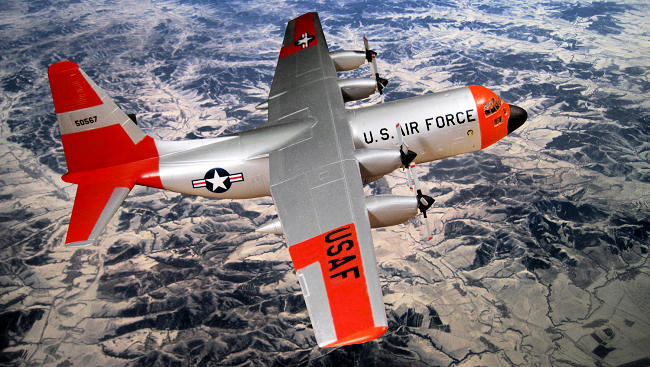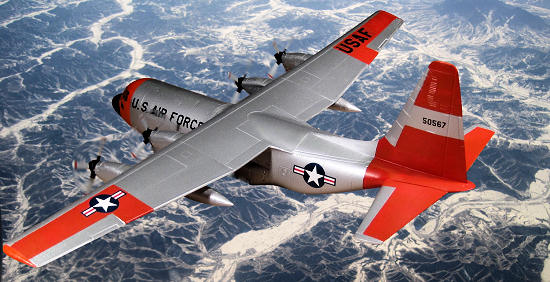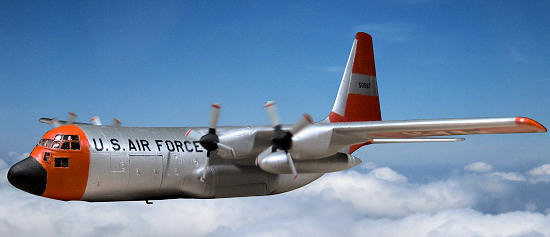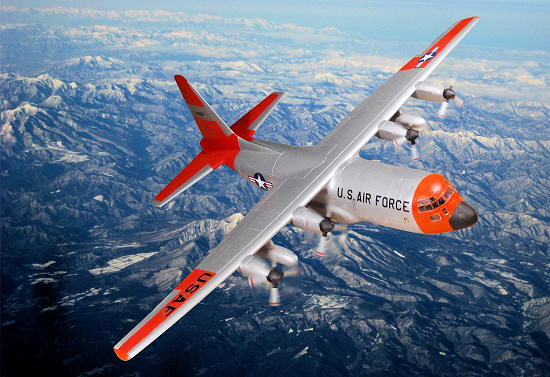
| KIT #: | ? |
| PRICE: | $10.00 about 15 years ago |
| DECALS: | CAF |
| REVIEWER: | Richard F |
| NOTES: |

| HISTORY |
Reviews of famous planes often start with
something like: "unless you've been living under a rock your whole modeling
life, you'll have heard of the F-4 Phantom, P-51 Mustang, Supermarine Spitfire,
etc".
Well, the same must be true of the legendary Lockheed C-130 Hercules. How could
anyone vaguely interested in aeroplanes not know the basics about the Herk?
 It's been
hauling people and stuff all around the world for more than 50 years in just
about every western (and many non-western) air force and plenty of cargo
companies to boot.
It's been
hauling people and stuff all around the world for more than 50 years in just
about every western (and many non-western) air force and plenty of cargo
companies to boot.
I wrote a pretty gushing review of the awesome Hercules in my review of
Hasegawa's excellent little 1/200 kit. If you're interested (or, by some
miracle, you did spend your modeling life under a rock), you can check it out
right here on MM.
If you can't be bothered with that but still want to know a little more, here's
the top three fast facts:
. coolest place ever landed by a C-130: equal tie between the South Pole and USS
Forrestal . wackiest mission ever flown: flying into the middle of a hurricane.
I mean, really?! Most bad-ass Herk (and it ain't the gunship): MC-130 Combat
Talon. Terrain following radar and great code names like Eagle Claw and Urgent
Fury. Hoo-rah!
| THE KIT |
 This is an
oldie but a goodie.
This is an
oldie but a goodie.
Mine was moulded in white plastic and sadly had a warped wing. Apart from that,
it's a good little kit for the most part, despite its age. A mix of lightly
raised and engraved detail greets you when you open the box. The rear door, in
two parts, could be positioned open or closed, but there is no internal detail.
The cockpit doesn't have any either, which on any other C-130 would be a let
down but on this one won't be noticed because the cockpit transparency is so
thick. It has the copyright date moulded underneath the tailplane.
Smaller details are pretty basic - wheels are nothing special, and neither are
the propellers. All are good enough, though.
| CONSTRUCTION |
 You need
some noseweight and black paint in the front part of the fuselage, but unless
you plan to position the rear door open, you can quickly join up the fuselage
and get onto the wings. Mine was warped. I squashed it down a bit after heating
it in hot water and most of the warp seemed to disappear though you'll see in
the pictures that there is still a bit of bend.
You need
some noseweight and black paint in the front part of the fuselage, but unless
you plan to position the rear door open, you can quickly join up the fuselage
and get onto the wings. Mine was warped. I squashed it down a bit after heating
it in hot water and most of the warp seemed to disappear though you'll see in
the pictures that there is still a bit of bend.
The least satisfactory part of building this thing is smoothing out the area
where the wings join the fuselage top. Sanding and putty is the only way around
it. The propellers are a bit lame, too, and need some effort to get them to sit
properly.
Getting the undercarriage on can be done after painting. My main wheel well
doors are MIA. Apart from that, this is a very simple kit to assemble.
| COLORS & MARKINGS |
 I really like
the old high-visibility schemes on C-130s. When I built this, I had an article
ripped out of a 1992 Fine Scale Modeller (I forget which month, and I don't have
the article any more), which had side and top profiles of various old USAF
high-visibility schemes. Some of them were used by C-130s that supported
Arctic/Antarctic operations.
I really like
the old high-visibility schemes on C-130s. When I built this, I had an article
ripped out of a 1992 Fine Scale Modeller (I forget which month, and I don't have
the article any more), which had side and top profiles of various old USAF
high-visibility schemes. Some of them were used by C-130s that supported
Arctic/Antarctic operations.
I used Tamiya AS-12 from a spray can for the aluminium sections, a Testors day-glo
orange for the nose and the extreme wingtips, and Humbrol bright red for the
larger red areas on the wings and tail. The nose and propeller spinners were
matt black (Tamiya) and the propeller blades are a light grey (also Tamiya).
Markings came from the spares box. The majority of them were actually from my
Revell 1/144 E-3 kit (I built that in the NATO scheme, so I didn't need the USAF
decals). I used a generic tail number, which reflected the 5-digit numbers used
in the FSM profile.
In that sense, my model is a generic representation, not a specific example. Not
to everyone's taste, but fine by me. I just like the Hercules and I like this
scheme.
| CONCLUSIONS |
The Minicraft 1/144 C-130 is probably a lot better. It's also probably considerably more expensive. If you just want a Hercules in a manageable scale, but you think the excellent Hasegawa 1/200 is too small, then go for this one. With a fraction of effort you can get a decent result.
| REFERENCES |
Three Cheers for Wikipedia.
March 2010
If you would like your product reviewed fairly and quickly, please contact me or see other details in the Note to Contributors.